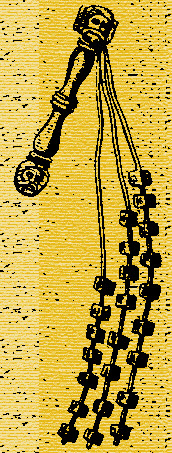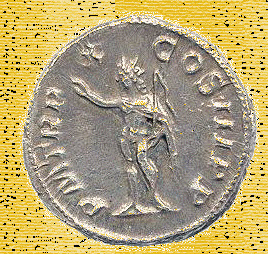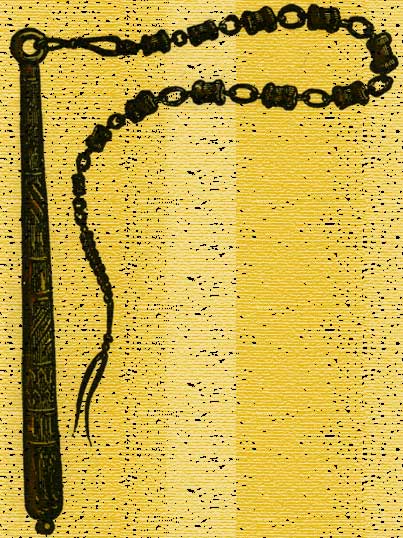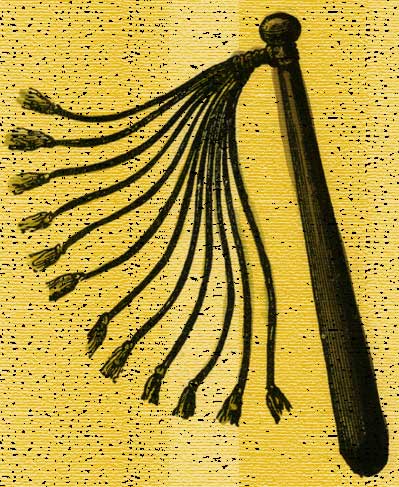The Roman Scourge

Roman Scourge
Instrument
The Romans would, according to
custom, scourge a condemned criminal before he was put to death. The
Roman scourge, also called the "flagrum" or "flagellum" was a short
whip made of two or three leather (ox-hide) thongs or ropes
connected to a handle as in the sketch above. The leather thongs
were knotted with a number of small pieces of metal, usually zinc
and iron, attached at various intervals. Scourging would quickly
remove the skin. According to history the punishment of a slave was
particularly dreadful. The leather was knotted with bones, or heavy
indented pieces of bronze.
Sometimes the Roman scourge contained a hook at the end and was
given the terrifying name "scorpion." The criminal was made to stoop
which would make deeper lashes from the shoulders to the waist.
According to Jewish law (discipline of the synagogue) the number of
stripes was forty less one (Deut. 25:3) and the rabbis reckoned 168
actions to be punished by scourging before the judges. Nevertheless,
scourging among the Romans was a more severe form of punishment and
there was no legal limit to the number of blows, as with the Jews.
Deep lacerations, torn flesh, exposed muscles and excessive bleeding
would leave the criminal "half-dead." Death was often the result of
this cruel form of punishment though it was necessary to keep the
criminal alive to be brought to public subjugation on the cross. The
Centurion in charge would order the "lictors" to halt the flogging
when the criminal was near death.
"But he was wounded for our
transgressions, he was bruised for our iniquities: the chastisement
of our peace was upon him; and with his stripes we are healed. All
we like sheep have gone astray; we have turned every one to his own
way; and the LORD hath laid on him the iniquity of us all." - Isaiah
53:5-6

Flagellum, Symbol of Sol
Notice on the above ancient Roman coin the flagellum is the symbol
of Sol the sun-god.
In ancient Rome crucifixion was
almost always preceded by the "flagrum" and thus it made the vision
of the crucified criminal all the more dreadful. Cicero called
crucifixion the "extreme and ultimate punishment of slaves" (servitutis
extremum summumque supplicium, Against Verres 2.5.169), and the
"cruelest and most disgusting penalty." (crudelissimum
taeterrimumque supplicium, ibid. 2.5. 165.) and Josephus called it
"the most pitiable of deaths." (Jewish War 7:203.)
"I gave my back to those who beat me, my cheeks to those who
plucked my beard; my face I did not shield from buffets and
spitting." - Isaiah 50:6
"Just as there were many who were appalled at him his appearance was
so disfigured beyond that of any man and his form marred beyond
human likeness" - Isaiah 52:14
"So, Pilate, wishing to satisfy the crowd, released to them
Barabbas; but Jesus he scourged and delivered to be crucified." -
Mark 15:15
Matthew 20:19 - And shall deliver him to the Gentiles to mock, and to scourge, and to crucify [him]: and the third day he shall rise again.
Matthew 20:19 - And shall deliver him to the Gentiles to mock, and to scourge, and to crucify [him]: and the third day he shall rise again.
Crucifixion was so horrifying to an enemy of Rome, and it was almost always preceded by scourging.
The Bible Mentions the Word "Scourge"
Matthew
23:34 - Wherefore, behold, I send unto you prophets, and
wise men, and scribes: and [some] of them ye shall kill and crucify;
and [some] of them shall ye scourge in your
synagogues, and persecute [them] from city to city:
John 2:15
- And when he had made a scourge of small cords, he
drove them all out of the temple, and the sheep, and the oxen; and
poured out the changers' money, and overthrew the tables;
Acts 22:25
- And as they bound him with thongs, Paul said unto the centurion
that stood by, Is it lawful for you to scourge a man
that is a Roman, and uncondemned?
Matthew
20:19 - And shall deliver him to the Gentiles to mock, and
to scourge, and to crucify [him]: and the third day he
shall rise again.
Matthew
10:17 - But beware of men: for they will deliver you up to
the councils, and they will scourge you in their
synagogues;
Mark 10:34
- And they shall mock him, and shall scourge him, and
shall spit upon him, and shall kill him: and the third day he shall
rise again.
Luke 18:33
- And they shall scourge [him], and put him to death:
and the third day he shall rise again.
Read The Bible
- 1599 Geneva Bible (GNV)
- 21st Century King James Version (KJ21)
- American Standard Version (ASV)
- Amplified Bible (AMP)
- Amplified Bible, Classic Edition (AMPC)
- Authorized (King James) Version (AKJV)
- BRG Bible (BRG)
- Christian Standard Bible (CSB)
- Common English Bible (CEB)
- Complete Jewish Bible (CJB)
- Contemporary English Version (CEV)
- Darby Translation (DARBY)
- Disciples’ Literal New Testament (DLNT)
- Douay-Rheims 1899 American Edition (DRA)
- Easy-to-Read Version (ERV)
- English Standard Version (ESV)
- English Standard Version Anglicised (ESVUK)
- Evangelical Heritage Version (EHV)
- Expanded Bible (EXB)
- GOD’S WORD Translation (GW)
- Good News Translation (GNT)
- Holman Christian Standard Bible (HCSB)
- International Children’s Bible (ICB)
- International Standard Version (ISV)
- J.B. Phillips New Testament (PHILLIPS)
- Jubilee Bible 2000 (JUB)
- King James Version (KJV)
- Lexham English Bible (LEB)
- Living Bible (TLB)
- Modern English Version (MEV)
- Mounce Reverse Interlinear New Testament (MOUNCE)
- Names of God Bible (NOG)
- New American Bible (Revised Edition) (NABRE)
- New American Standard Bible (NASB)
- New American Standard Bible 1995 (NASB1995)
- New Catholic Bible (NCB)
- New Century Version (NCV)
- New English Translation (NET)
- New International Reader's Version (NIRV)
- New International Version - UK (NIVUK)
- New International Version (NIV)
- New King James Version (NKJV)
- New Life Version (NLV)
- New Living Translation (NLT)
- New Matthew Bible (NMB)
- New Revised Standard Version (NRSV)
- New Revised Standard Version Catholic Edition (NRSVCE)
- New Revised Standard Version, Anglicised (NRSVA)
- New Revised Standard Version, Anglicised Catholic Edition (NRSVACE)
- New Testament for Everyone (NTE)
- Orthodox Jewish Bible (OJB)
- Revised Geneva Translation (RGT)
- Revised Standard Version (RSV)
- Revised Standard Version Catholic Edition (RSVCE)
- The Message (MSG)
- The Voice (VOICE)
- Tree of Life Version (TLV)
- World English Bible (WEB)
- Worldwide English (New Testament) (WE)
- Wycliffe Bible (WYC)
- Young's Literal Translation (YLT)
Table of Contents
Main Menu
- Ancient Assyrian Social Structure
- Ancient Babylonia
- Ancient Canaan During the Time of Joshua
- Ancient History Timeline
- Ancient Oil Lamps
- Antonia Fortress
- Archaeology of Ancient Assyria
- Assyria and Bible Prophecy
- Augustus Caesar
- Background Bible Study
- Bible
- Biblical Geography
- Fallen Empires - Archaeological Discoveries and the Bible
- First Century Jerusalem
- Glossary of Latin Words
- Herod Agrippa I
- Herod Antipas
- Herod the Great
- Herod's Temple
- High Priest's in New Testament Times
- Jewish Literature in New Testament Times
- Library collection
- Map of David's Kingdom
- Map of the Divided Kingdom - Israel and Judah
- Map of the Ministry of Jesus
- Matthew Henry Bible Commentary
- Messianic Prophecy
- Nero Caesar Emperor
- Online Bible Maps
- Paul's First Missionary Journey
- Paul's Second Missionary Journey
- Paul's Third Missionary Journey
- Pontius Pilate
- Questions About the Ancient World
- Tabernacle of Ancient Israel
- Tax Collectors in New Testament Times
- The Babylonian Captivity
- The Black Obelisk of Shalmaneser
- The Books of the New Testament
- The Court of the Gentiles
- The Court of the Women in the Temple
- The Destruction of Israel
- The Fall of Judah with Map
- The History Of Rome
- The Incredible Bible
- The Jewish Calendar in Ancient Hebrew History
- The Life of Jesus in Chronological Order
- The Life of Jesus in Harmony
- The Names of God
- The New Testament
- The Old Testament
- The Passion of the Christ
- The Pharisees
- The Sacred Year of Israel in New Testament Times
- The Samaritans
- The Scribes
Ancient Questions
- Why Do the Huldah Gates Appear Different in Ancient Replicas and Modern Photos?
- What Is the Origin of the Japanese and Chinese Peoples? A Biblical Perspective
- How did the ancient Greeks and Romans practice medicine and treat illnesses?
- What were the major contributions of ancient Babylon to mathematics and astronomy?
- How did the ancient Persians create and administer their vast empire?
- What were the cultural and artistic achievements of ancient India, particularly during the Gupta Empire?
- How did ancient civilizations like the Incas and Aztecs build their remarkable cities and structures?
- What were the major trade routes and trading practices of the ancient world?
- What was the role of slavery in ancient societies like Rome and Greece?
- How did the ancient Mayans develop their sophisticated calendar system?
Bible Study Questions
- Why Do Christians Celebrate Christmas?
- How Many Chapters Are There in the Bible?
- The Five Key Visions in the New Testament
- The 400-Year Prophecy: Unpacking Genesis 15 and the Journey of a People
- The Authorized (King James) Version (AKJV): Historical Significance, Translation Methodology, and Lasting Impact
- Exploring the English Standard Version (ESV): Its Aspects, Comparisons, Impact on Biblical Studies, and Church Use
- A Detailed Historical Analysis of Language Updates in the KJ21: Comparison with Other Versions
- A Detailed Historical Analysis of the American Standard Version (ASV): Comparison to the King James Version, Influence on Later Translations, and Evaluation of Strengths and Weaknesses
- A Detailed Historical Analysis of Amplifications in the Amplified Bible (AMP) and Its Comparison to Other Bible Translations
- Detailed Historical Analysis of the Amplified Bible Classic Edition (AMPC): Examples of Amplifications and Comparative Analysis with Other Bible Translations
About
Welcome to Free Bible: Unearthing the Past, Illuminating the Present! Step into a world where ancient history and biblical narratives intertwine, inviting you to explore the rich tapestry of human civilization.
Discover the captivating stories of forgotten empires, delve into the customs and cultures of our ancestors, and witness the remarkable findings unearthed by dedicated archaeologists.
Immerse yourself in a treasure trove of knowledge, where the past comes alive and illuminates our understanding of the present.
Join us on this extraordinary journey through time, where curiosity is rewarded and ancient mysteries await your exploration.
Recent posts
-

AI Platforms in 2025: The Most Powerful Tools for Businesses and Developers
Artificial intelligence (AI) has swiftly advanced, becoming an vital device for organizations and builders throughout industries. As we enter 2025, AI... -

The Role of AI in Cryptocurrency Trading and Blockchain Security
Artificial Intelligence (AI) is rapidly reworking industries, and the cryptocurrency sector is not any exception. From enhancing trading techniques to... -

The impact of IP address on LinkedIn traffic
IP address has a serious impact on LinkedIn traffic. Before you start working with the site, you should clarify the specifics of this influence and ho... -

The Bible in Museums: Where to See Ancient Scripture Today
The Bible, as one of the most influential books in human history, has shaped not only religious beliefs but also the course of civilization. Its stori... -

How AI is Revolutionizing 2025: Latest Innovations and Industry Applications
Artificial Intelligence (AI) has turn out to be one of the maximum transformative technologies of the twenty first century. As we flow via 2025, AI ke...

